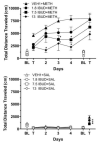The glial cell modulators, ibudilast and its amino analog, AV1013, attenuate methamphetamine locomotor activity and its sensitization in mice
- PMID: 22306241
- PMCID: PMC3973724
- DOI: 10.1016/j.ejphar.2012.01.013
The glial cell modulators, ibudilast and its amino analog, AV1013, attenuate methamphetamine locomotor activity and its sensitization in mice
Abstract
Over 800,000 Americans abuse the psychomotor stimulant, methamphetamine, yet its abuse is without an approved medication. Methamphetamine induces hypermotor activity, and sensitization to this effect is suggested to represent aspects of the addiction process. Methamphetamine's regulation of 3'-5'-cyclic adenosine monophosphate (cAMP) levels may be partially responsible for its behavioral effects, and compounds that inhibit phosphodiesterase (PDE), the enzyme that degrades cAMP, can alter methamphetamine-induced behaviors. Methamphetamine also activates glial cells and causes a subsequent increase in pro-inflammatory cytokine levels. Modulation of glial cell activation is associated with changes in behavioral responses, and substances that oppose inflammatory activity can attenuate drug-induced behaviors. Ibudilast (aka AV411; 3-isobutyryl-2-isopropylpyrazolo-[1,5-a]pyridine), inhibits both PDE and glial pro-inflammatory activity. Ibudilast's amino analog, AV1013, modulates similar glial targets but negligibly inhibits PDE. The present study determined whether ibudilast and AV1013 would attenuate methamphetamine-induced locomotor activity and its sensitization in C57BL/6J mice. Mice were treated b.i.d. with ibudilast (1.8-13 mg/kg), AV1013 (10-56 mg/kg) or their vehicles intraperitoneally for 7 days, beginning 48 h before 5 days of daily 1-h locomotor activity tests. Each test was initiated by either a methamphetamine (3 mg/kg) or a saline injection. Ibudilast significantly (P<0.05) reduced the acute, chronic, and sensitization effects of methamphetamine's locomotor activity without significantly affecting activity by itself. AV1013 had similar anti-methamphetamine effects, suggesting that glial cell activity, by itself, can modulate methamphetamine's effects and perhaps serve as a medication target for its abuse.
Copyright © 2012 Elsevier B.V. All rights reserved.
Figures


Similar articles
-
Glial cell modulators attenuate methamphetamine self-administration in the rat.Eur J Pharmacol. 2013 Feb 15;701(1-3):124-30. doi: 10.1016/j.ejphar.2013.01.016. Epub 2013 Jan 31. Eur J Pharmacol. 2013. PMID: 23375937 Free PMC article.
-
The glial cell modulator and phosphodiesterase inhibitor, AV411 (ibudilast), attenuates prime- and stress-induced methamphetamine relapse.Eur J Pharmacol. 2010 Jul 10;637(1-3):102-8. doi: 10.1016/j.ejphar.2010.04.010. Epub 2010 Apr 23. Eur J Pharmacol. 2010. PMID: 20399770 Free PMC article.
-
Safety of Intravenous Methamphetamine Administration During Ibudilast Treatment.J Clin Psychopharmacol. 2016 Aug;36(4):347-54. doi: 10.1097/JCP.0000000000000511. J Clin Psychopharmacol. 2016. PMID: 27269956 Free PMC article. Clinical Trial.
-
Ibudilast: a non-selective PDE inhibitor with multiple actions on blood cells and the vascular wall.Cardiovasc Drug Rev. 2001 Fall;19(3):215-25. doi: 10.1111/j.1527-3466.2001.tb00066.x. Cardiovasc Drug Rev. 2001. PMID: 11607039 Review.
-
Neuroimmune basis of methamphetamine toxicity.Int Rev Neurobiol. 2014;118:165-97. doi: 10.1016/B978-0-12-801284-0.00007-5. Int Rev Neurobiol. 2014. PMID: 25175865 Free PMC article. Review.
Cited by
-
KVA-D-88, a Novel Preferable Phosphodiesterase 4B Inhibitor, Decreases Cocaine-Mediated Reward Properties in Vivo.ACS Chem Neurosci. 2020 Aug 5;11(15):2231-2242. doi: 10.1021/acschemneuro.0c00170. Epub 2020 Jul 17. ACS Chem Neurosci. 2020. PMID: 32609488 Free PMC article.
-
Glial modulators as potential treatments of psychostimulant abuse.Adv Pharmacol. 2014;69:1-69. doi: 10.1016/B978-0-12-420118-7.00001-9. Adv Pharmacol. 2014. PMID: 24484974 Free PMC article. Review.
-
Methamphetamine decreases K+ channel function in human fetal astrocytes by activating the trace amine-associated receptor type-1.J Neurochem. 2019 Jan;148(1):29-45. doi: 10.1111/jnc.14606. Epub 2018 Nov 19. J Neurochem. 2019. PMID: 30295919 Free PMC article.
-
Targeting the Toll of Drug Abuse: The Translational Potential of Toll-Like Receptor 4.CNS Neurol Disord Drug Targets. 2015;14(6):692-9. doi: 10.2174/1871527314666150529132503. CNS Neurol Disord Drug Targets. 2015. PMID: 26022268 Free PMC article. Review.
-
Cross-talk between microglia and neurons regulates HIV latency.PLoS Pathog. 2019 Dec 30;15(12):e1008249. doi: 10.1371/journal.ppat.1008249. eCollection 2019 Dec. PLoS Pathog. 2019. PMID: 31887215 Free PMC article.
References
-
- Beattie EC, Stellwagen D, Morishita W, Bresnahan JC, Ha BK, Von Zastrow M, Beattie MS, Malenka RC. Control of synaptic strength by glial TNFalpha. Science. 2002;295:2282–2285. - PubMed
-
- Beavo JA. Cyclic nucleotide phosphodiesterases: functional implications of multiple isoforms. Physiol. Rev. 1995;75:725–748. - PubMed
-
- Bigelow GE, Griffiths RR, Liebson IA. Pharmacological influences upon human ethanol self-administration. Adv. Exp. Med. Biol. 1977;85B:523–538. - PubMed
-
- Caporaso GL, Bibb JA, Snyder GL, Valle C, Rakhilin S, Fienberg AA, Hemmings HC, Nairn AC, Greengard P. Drugs of abuse modulate the phosphorylation of ARPP-21, a cyclic AMP-regulated phosphoprotein enriched in the basal ganglia. Neuropharmacology. 2000;39:1637–1644. - PubMed
Publication types
MeSH terms
Substances
Grants and funding
LinkOut - more resources
Full Text Sources
Medical

